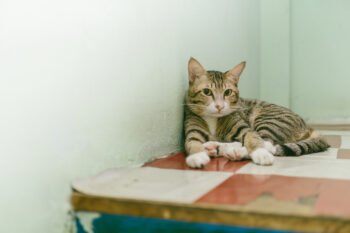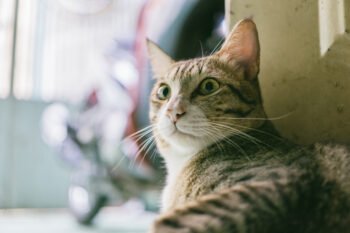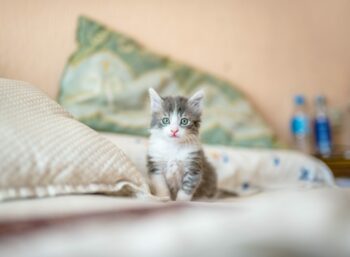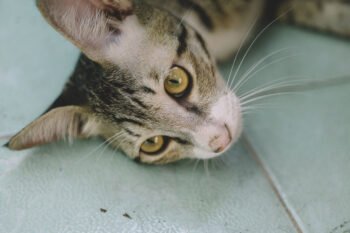Pam Johnson-Bennett’s two pet cats are a mother-and-daughter team. But despite the shared genes, the two felines couldn’t be more different when it comes to preferences at playtime. The mother, Mary, likes to leap into the air after toys, as if hunting a bird. The daughter, Bebe, prefers stalking pretend prey on the ground, as if pursuing a mouse.
The one commonality: both cats like to play predator.
“All felines play the same way, whether playing with a speck of dust or a mouse,” says Johnson-Bennett, a certified animal behavior consultant and author of Starting from Scratch: How to Correct Behavior Problems in Your Adult Cat (Penguin). “They take on the same posture, slink down, stalk and pounce — whether it’s a tiger on the savanna or the tiger in your living room.”
Domestic cats like to play the way a cat would behave in the wild. This type of play can both meet a cat’s physical and emotional needs. For cats that don’t get enough challenging playtime, life can become boring and lonely — for them, an incredibly stressful reality — making them lethargic and prone to illness.
In order to vary playtime specifically for your cat, there are two types of beneficial predatory play. Some felines favor ground hunting, while others prefer more aerial pursuits. Here’s how to discover the predator in your furry friend for a positive playtime:
Finding the Inner Ground Hunter
Determining whether a pet prefers to stalk pretend prey on the ground, or in the air, is a matter of trial and error. See how your pet responds to ground play and aerial games, suggests Mikel Delgado, a cat behavior specialist at the San Francisco Society for the Prevention of Cruelty to Animals (SFSPCA). Some cats — but not all — have very distinct preferences for one type of play or the other, Johnson-Bennett says.
There are right ways and wrong ways, however, to try to coax your pet into pouncing on a would-be rodent on the ground:
- Try a variety of toys Your interactive toys can be homemade or store-bought. Johnson-Bennett recommends toys on a wire that can spring back and forth. But a balled up piece of paper and a string might work, as well.
- Simulate a variety of ground movements “I always tell clients to think like prey,” Johnson-Bennett says. “Prey is not moving around wildly in front of the cat. Find a place to hide the toy and then another place. Use little, quivering movements.”
- Don’t touch your pet with the toy “People are confused when they get an irritated response rather than a predatory response,” Delgado says. “It’s very unlikely that any mouse or bird, for that matter, would walk up to a cat and say, in effect, ‘Come and get me.'”
- Allow your cat to taste success Let them swat the toy with a paw. Allow them to pounce on the toy first before pulling it away. Little victories serve to build up your pet’s confidence, Johnson-Bennett says.
- End on a positive note Let your feline experience the thrill of victory. It will make them want to play again. You may want to end your play with a meal or treat — a reward they would get in the wild.
There are some cautions, experts say. Don’t use a hand or other body part as the pretend prey, warns Suzanne Hetts, an animal behaviorist in Littleton, Colo. who runs Helping Kitty, because you could end up getting hurt and confusing kitty when you use that same hand to try to stroke your pet. Also, never leave the cat alone on the ground with a string toy because they could swallow it and end up wreaking havoc on their digestive systems, Delgado says.
Identifying a Feline that Favors Aerial Hunting
If ground play doesn’t engage your kitty, go airborne with your toys. Aerial play is often for the more athletic feline who likes to leap up, jump onto furniture and sometimes do flips in the air. Here are steps to create an inviting aerial hunting game for your cat:
- Give kitty a warm up Little jumps are good before progressing to full-blown aerial leaps, Delgado says.
- Try toys attached to a pole or wire They can allow you to simulate quick, bird-like movements.
- Think like a bird A bird would not be in flight all the time, Johnson-Bennett says. “It lands on the ground. Walks a bit. Flies around again and walks again.”
- Let your cat climb You may not like to encourage your cat to jump up on the table, but climbing up a cat condo to get a better look at the prey might be fun and provide more exercise.
- Let kitty reap rewards Allow your cat to catch its prey. As with ground-hunting, it gives your pet confidence to get their paws on the play toy every now and then. You may want to end with a food reward.
Once you discover which type of “hunter” your pet is, you can work to keep playtime active and help your feline’s overall health. Also, be sure to put the special toys away between play times. “Leave out the balls and furry mice,” Johnson-Bennett says. “But the interactive toys are special and shouldn’t be handing around — just as mice and birds aren’t always hanging around.”






